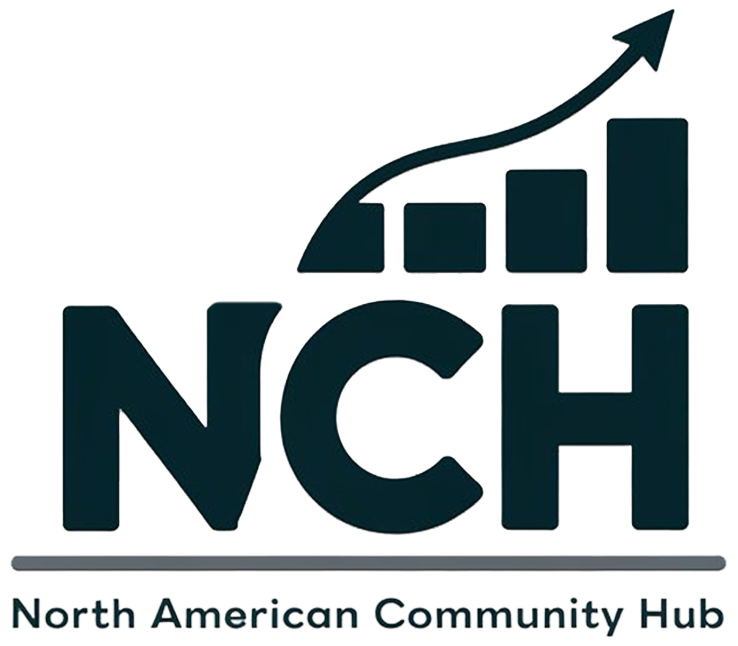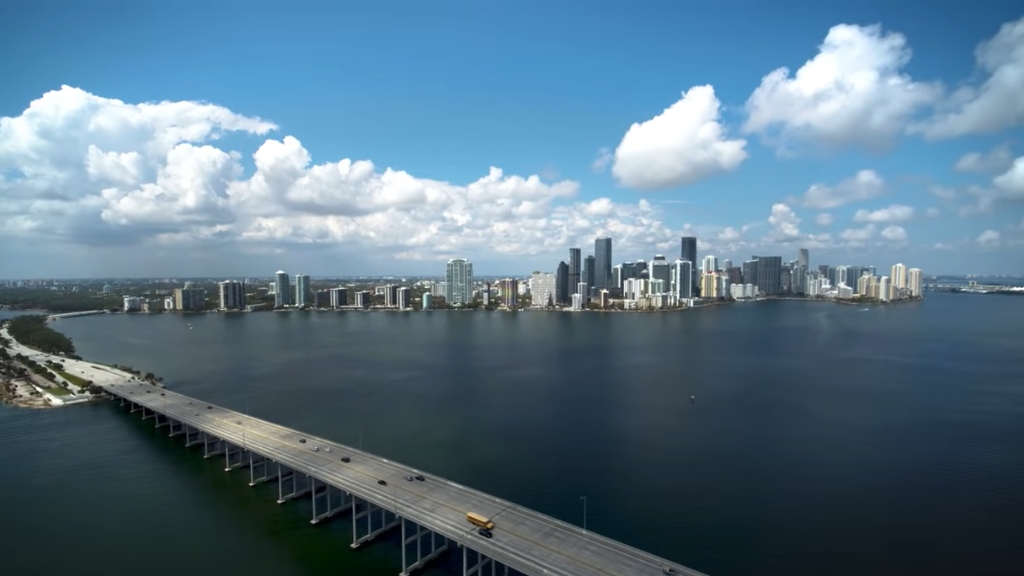The Sunshine State’s population jumped by 1.9% in 2022 and added another 1.6% in 2023, nearly outpacing every other state in the country, according to the Census.
Cities like Orlando, Tampa, and Miami collectively added nearly 150,000 people between 2022 and 2023, with metro areas like Wildwood-The Villages, Lakeland-Winter Haven, Ocala, and Port St. Lucie ranking among the fastest-growing in the entire country.
Polk County, where cities like Davenport and Haines City are located, led the U.S. with the highest net domestic migration, adding over 26,000 residents in a single year.
And it’s not just the big cities seeing this explosion. Smaller towns and newly developed communities like Westlake, which grew by a staggering 21.5% annually from 2020 to 2025, are rewriting Florida’s growth story, as per WLRN.
All told, Florida’s urban population has been growing by an average of 6.6% per year, turning it into a true magnet for families, retirees, and businesses.
Top Fastest-Growing Cities in Florida
See which Central Florida cities have grown the fastest and which local town is among the fastest-growing in the country. https://t.co/ZXoEvzYKyu
— Orlando Business Journal (@OBJUpdate) May 18, 2025
Among the 764 Florida cities with over 1,000 residents, several are seeing growth far beyond the state average. Many of these places were small or overlooked just a few years ago—but that’s changed quickly. Below is a more detailed snapshot of the top cities based on annualized growth from 2020 to 2025.
| City | Growth Rate | 2025 Population | 2020 Population |
| Westlake (Palm Beach Co.) | 21.57% | 9,299 | 1,048 |
| Davenport (Polk Co.) | 10.58% | 18,632 | 9,721 |
| Eagle Lake (Polk Co.) | 8.13% | 4,907 | 3,062 |
| Haines City (Polk Co.) | 7.70% | 43,487 | 27,949 |
| Rainbow Park (Marion Co.) | 7.16% | 2,574 | 1,522 |
| Palmer Ranch (Sarasota Co.) | 7.15% | 19,098 | 13,802 |
| Verandah (Lee Co.) | 7.15% | 2,144 | 1,291 |
| North Merritt Island | 7.15% | 11,291 | 8,343 |
| Liberty Triangle (Marion Co.) | 7.14% | 28,890 | 20,936 |
| On Top of the World (Marion Co.) | 7.14% | 16,320 | 10,916 |
| Lakewood Ranch (Manatee Co.) | 7.14% | 42,932 | 26,513 |
| Ave Maria (Collier Co.) | 7.14% | 7,369 | 4,110 |
| Marion Oaks (Marion Co.) | 7.14% | 25,354 | 19,068 |
What Are the Numbers Showing?
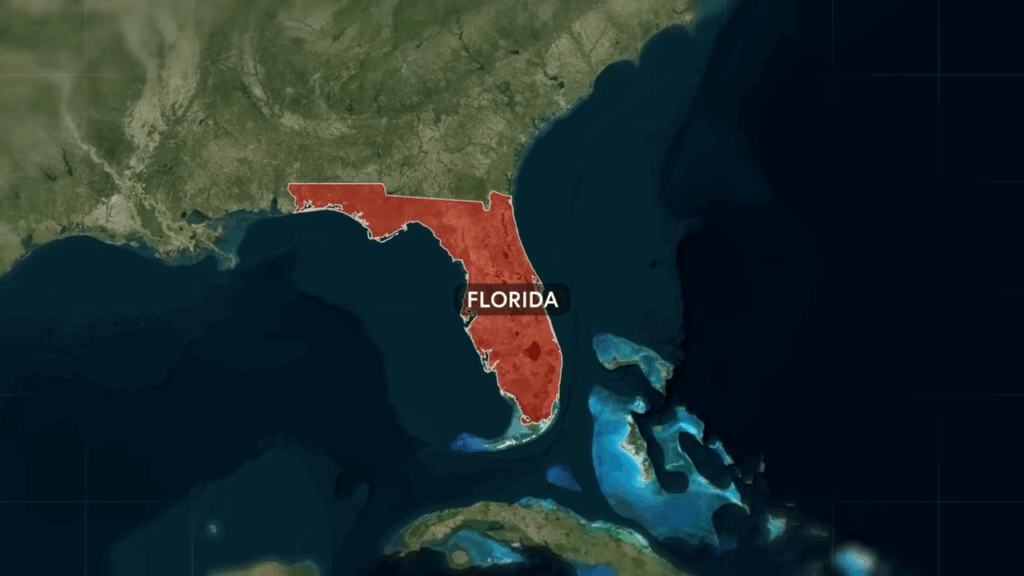
1. New Cities, Big Ambitions
Let’s start with Westlake, sitting at the top with jaw-dropping growth of over 21%. This city didn’t even exist a decade ago. Built from scratch in Palm Beach County, it’s a master-planned community with a focus on young families, modern infrastructure, and schools within walking distance of homes.
It’s the textbook example of a city designed for today’s buyers: tech-friendly, safe, and scalable.
Then you have places like Davenport and Haines City, where growth is more organic. Located in Polk County, these cities sit within driving distance of both Orlando and Tampa. That makes them commuter hubs, but they’re no longer just bedroom communities.
Developers are bringing in retail, healthcare, and job opportunities, turning what used to be sleepy towns into self-contained cities with their own rhythm.
2. Marion County’s Quiet Rise
Marion County doesn’t usually make headlines, but look closer and you’ll see several of Florida’s fastest-growing cities are clustered here. 352today notes that Marion Oaks, Liberty Triangle, Rainbow Park, and On Top of the World are all seeing explosive population jumps between 6.5% and 7.5% annually.
The appeal? Affordable land, low taxes, and a short drive to both the Ocala metro area and Gainesville. Developers are building fast, and a lot of the new residents are retirees, younger families, and remote workers priced out of South Florida.
Places like On Top of the World are designed around the retirement lifestyle, complete with golf courses, wellness centers, and gated communities.
3. Coastal Growth with a Twist
Palmer Ranch and North Merritt Island are interesting cases. They’re not brand new, but they’re experiencing a wave of revitalization. Palmer Ranch is just south of Sarasota and has attracted a lot of interest from downsizing boomers and vacation homeowners.
View this post on Instagram
North Merritt Island, near the Kennedy Space Center, is seeing a spillover from tech and aerospace employment. NASA contractors, engineers, and logistics specialists are moving in, pushing housing demand and raising median home prices.
Even smaller places like Verandah, near Fort Myers, and Ave Maria, a planned Catholic university town in Collier County, are gaining population quickly. Verandah offers riverfront access and ga golf lifestyle, while Ave Maria has carved out a niche with religious and private-school-focused families.
Why It’s Happening Now
A few big-picture forces are behind all of this rapid city growth:
1. Migration from Expensive States
Heritage Foundation notes that people are leaving places like New York, Illinois, and California. Florida offers lower taxes, fewer regulations, and better weather. When remote work became normal, the floodgates opened. Cities that had room to grow—literally—are absorbing the influx.
2. Cheaper Land Means More Housing
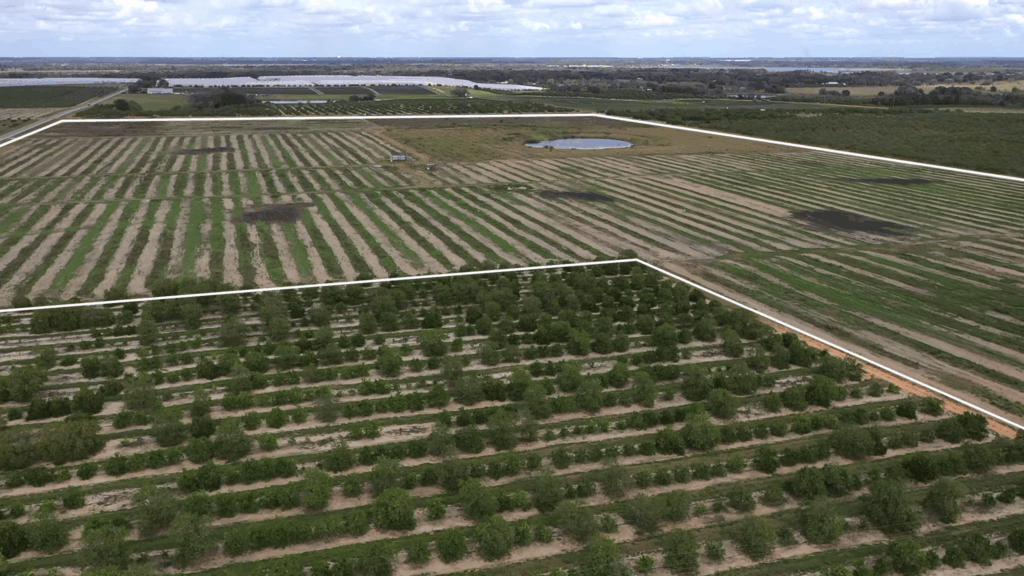
Counties like Polk and Marion still have large tracts of undeveloped land, much of it former farmland. Developers are building fast, and the prices are still attractive for both first-time homebuyers and retirees.
3. Strategic Locations
Cities that sit between major metros are winning big. For example:
- Davenport and Haines City are right between Orlando and Tampa.
- Marion Oaks and Liberty Triangle offer access to both Ocala and The Villages.
- Westlake is close to the coast, but far enough inland to offer lower prices.
These cities offer the best of both worlds—access to amenities, without the price tag of a big metro.
But Growth Brings Pressure
As exciting as the growth is, it comes with some tension. Cities like Davenport and Lakewood Ranch are already wrestling with traffic congestion, school crowding, and infrastructure that wasn’t built for this kind of surge.
Water usage, public transportation, and long-term zoning plans are front-and-center issues in city council meetings across these counties. Residents want the perks of growth—shopping centers, good schools, medical facilities—but they’re wary of losing green space and a sense of community.
In cities like Ave Maria, where development came fast, there are growing pains. Some residents have raised concerns about whether retail, jobs, and road systems are keeping up with the housing boom.
What’s Fueling Florida’s Urban Growth?
@floridadallas Florida’s Population Reaches 23 Million #florida #floridanews #fl #miami #tampa #orlando #jacksonville #keywest #floridalife #floridakeys #disneyworld #population #cities #fortlauderdale #westpalmbeach #jupiter #floridaman #floridacheck #lovefl #fortmyers #capecoral #swfl #southflorida #news #density #jacksonville #destin #pensacola #floridabeaches #movingtoflorida #southflorida #keylargo #sarasota #ocala ##greenscreen ♬ Positive Vibes – Soundbeaver
Several key trends are behind Florida’s urban population boom:
- Migration from Other States: Many people from the Northeast and Midwest are choosing Florida for its warmer climate, lower taxes, and more affordable housing.
- Job Opportunities: Florida’s growing industries—including tourism, tech, and healthcare—are pulling in workers at all levels.
- Lifestyle Appeal: Florida offers a blend of city life, natural beauty, and a pace that appeals to both young professionals and retirees.
Polk County, which includes cities like Lakeland, Davenport, and Haines City, saw the highest net domestic migration in the U.S. in 2023, adding nearly 30,000 residents in just one year. Why? Development of former agricultural lands, equidistant access to Orlando and Tampa, and a robust housing market.
Metro Areas: The Big Picture
If you look at metro areas, Florida claims four of the five fastest-growing in the country:
- Wildwood-The Villages: The nation’s fastest-growing metro area, up nearly 5% in 2023. The Villages’ reputation as a top retirement community isn’t slowing down.
- Lakeland-Winter Haven: Growth of nearly 4%, driven by Polk County’s rapid development.
- Ocala and Port St. Lucie: Each grew by over 3%, offering a mix of suburban growth and a lifestyle that blends affordability with amenities.
Interestingly, Orlando-Kissimmee-Sanford, Tampa-St. Petersburg-Clearwater, and Miami-Fort Lauderdale-West Palm Beach collectively added about 150,000 people from 2022 to 2023—numbers that rank among the top 10 metro gains nationwide.
The Fastest-Growing Counties
Let’s zoom in on counties that are experiencing the fastest growth:
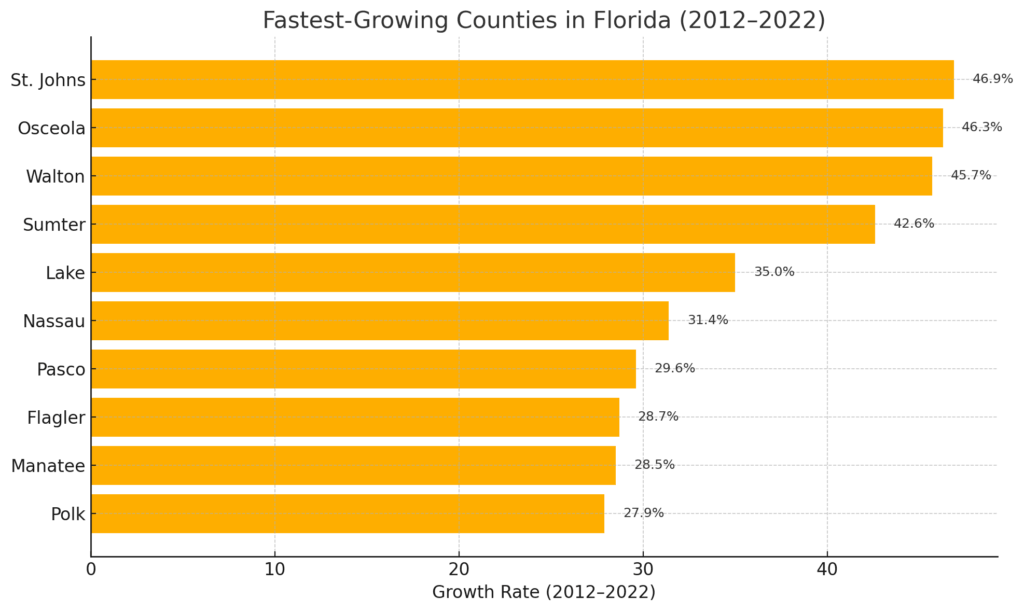
St. Johns County, near Jacksonville, is leading with nearly 47% growth over a decade. Pasco County, bordering Tampa, added over 23,000 residents in 2023 alone, according to the Business Journal. These numbers tell a clear story—Florida’s growth is concentrated in specific, opportunity-rich counties.
What’s So Special About Polk County?
You’ve probably noticed Polk County keeps popping up. Why is it such a magnet for growth? The area is turning old citrus groves and farmlands into sprawling residential communities. It’s also strategically located between Orlando and Tampa, offering access to both while maintaining a suburban feel.
Add in a mix of schools, shopping, and healthcare facilities, and you’ve got a winning formula. It’s not just about housing; it’s about lifestyle. And with a cost of living that’s generally lower than in coastal metros, it’s no surprise Polk County topped the charts in 2023.
Smaller Cities on the Rise
Beyond the big players, plenty of smaller cities are seeing impressive growth. Here are a few standouts:
- Eagle Lake (8.13%): A quaint city that’s expanding rapidly, attracting families looking for affordable homes.
- Rainbow Park (7.16%): This unincorporated community offers rural charm with proximity to Ocala.
- Lake Kerr and Hurlburt Field (both 7.15%): While Lake Kerr is a hidden gem with waterfront appeal, Hurlburt Field’s growth is tied to its Air Force Base and local development.
These places highlight a trend of growth not just in the big metros, but also in the quieter corners of the state.
Challenges and Opportunities
Of course, rapid growth brings challenges. Infrastructure, transportation, and housing affordability are hot topics in counties like Polk and Pasco.
Some areas are racing to expand roads and schools to keep up. At the same time, local governments and developers are seeing opportunities—think master-planned communities, expanded healthcare networks, and innovative transit solutions.
There’s also a demographic shift at play. While retirees are still a significant segment of Florida’s growth, younger professionals and families are increasingly part of the mix. Remote work trends mean people can choose Florida’s lifestyle without sacrificing career ambitions.
Final Thoughts
Florida’s population boom is more than just numbers—it’s reshaping the state’s identity. From the retirees fueling growth in The Villages to the young families flocking to Polk County’s suburbs, Florida is evolving into a diverse, dynamic place that’s more than just beaches and theme parks.
Like many parts of North America, rapid urban growth is transforming how communities form, expand, and connect.
Whether you’re eyeing a move, considering investing, or simply curious about the state’s future, it’s clear that Florida is on a fast track. The fastest-growing cities, Westlake, Davenport, and Eagle Lake, are just the beginning. And the growth in counties like Polk, Pasco, and St. Johns isn’t slowing down anytime soon.
Stay tuned. Florida’s boom story is still unfolding, and it’s one worth watching.

